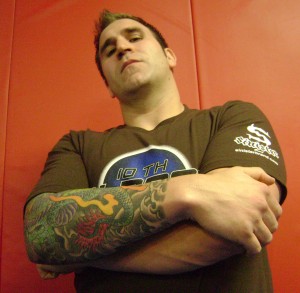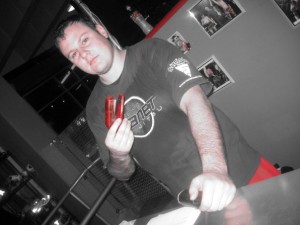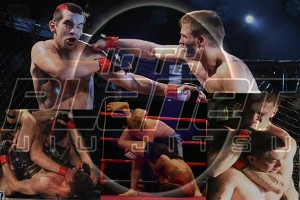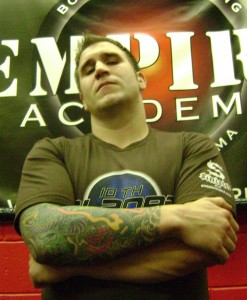Eddie Bravo On Gi vs. No-gi Training
September 8th, 2009Taken from www.mixedmartialarts.com. Big ups to Alaina Hardie for brining this to my attention. Link to thread.
“When all the greco roman Olympians striving for the gold in the Olympics
train both then I will bring back the gi for my students sake.
Marcelo is very good with the gi, but he doesn’t separate from the pack in
the gi like he does no-gi. In no-gi he is the supreme god. Think about the
gi gods in the game over the last 10 years. Think of their names. Think of
the ones that were KIngs in the gi but for some reason it never translated
to ADCC. Forget about the few that did make the transition beautifully like
Roger, Jacare, and of course the no-gi Jesus, Marcelo. Forget about them for
just one second. Think about all the other amazing multiple time Mundial
champions out there that never did much no-gi.
Why is that? Why is there so many?
Why does Marcelo do so much better no-gi than gi? Again, I know he has won
the mundials a few times but I can think of a few guys that had unbelievable
dominating reigns that eclipse what Marcelo has done with the gi.
But when it comes to no-gi, Marcelo is light years ahead of them. Why?
The answer is that, like all greco roman wrestlers, Marcelo understands that
the clinch must be mastered. The clinch in every position must be mastered.
Just like the plum clinch in Muay Thai, he who has the most polished plum
clinch lands more knees.
Marcelo works on his clinch on a daily basis, clinching medicine balls, and
clinching the over/under control while riding on dudes backs. He clinches
and rides and works on his clinching endurance without even going for the
choke. He’ll ride and clinch for a few minutes working on his squeezing
endurance before securing the choke. He understands that every different no
gi position requires a different clinch to be mastered there. I know
Marcelo, I am not talking out of my ass.
Marcelo is the no-gi god because he has a stronger, tighter, harder clinch
than any other bjj player on the planet. Clinching and squeezing while
moving into scoring position and clincing and squeezing while choking
someone out. In no-gi grappling, it’s all about how powerful your squeeze
is.
To be super offensive no-gi you must develope your clinches AND master all
clinches. Every second you train with the gi you are not training your
clinch. You are training your yank and pull. Totally different. Totally
different muscles, totally different base. If you want to get offensive in
no-gi like Marcelo, then when are you working on your clinch? Unless you
train no-gi grips with the gi on like some do, you are not working your
clinch if you are grabbing the gi.
But you don’t need to develope your clinch for defense. You need to develope
pushing explosion for defense, which you can get from gi training but you
also get that from no-gi training as well. That’s why gi guys with no clinch
are still very hard to finish in no-gi competition. Explosiveness, posture
and core strength are more important for defense than developing a clinch.
Every time you train in the gi and set up a submission while yanking on
collars and sleeves you are not working on your clinch, it’s that simple.
When I get into these gi/no-gi debates, it always ends up with the gi people
never giving me specific explanations of how the gi makes your nogi game
“tighter”. All they end up saying is, “Roger, Marcelo and Jacare train in
the gi so I’m gonna train in the gi”, no break downs like the ones I’m
giving. I am giving you detailed explanations and anaolgies, but all I get
in return is,”But you trained in the gi!” and stuff like that.
Machida, Anderson, and GSP all have black belts in Karate or TKD, does that
mean that all mma fighters should start training Karate? Most submission
fiends all came from the gi, that’s all there was in the 90’s. If you were
fascinated by chokes and breaking limbs, you had to put a gi on. Even now,
most schools that specialize in submissions make you wear a gi.
And the “What about defense?” arguement. Well, yes , it’s harder to explode
out of submissions with a gi, so you are working your defensive
explosiveness but how do you defend leg locks with a gi? The answer is hold
on to your opponent’s collar. How does that make your no-gi game “tighter?”
How do you defend kimura’s in the gi? The answer is grab on to your pants.
How does that make your no-gi game “tighter?”
How do you defend against arm bars? The answer is hold on to your own
collar. How does that make your no-gi game “tighter?”
How do you defend against rear naked chokes? The answer is cross your wrists
under your chin and hold on to both your collars. How does that make your
no-gi game “tighter?”
Even when you’re on top caught in a triangle, a very popular escape is to
grab your opponent’s collar and push it down across his neck while stacking
him. How does that make your no-gi defense better again?
Judo and Greco have the same goal, throw your opponent. Judo with yanking
and pulling the gi, Greco with clinching and squeezing overhooks and
underhooks.
Bjj and sub grappling have the same goal, pass guard and submit. BJJ with
yanking and pulling the gi, sub grappling with clinching and squeezing
overhooks and underhooks. That’s it, I can’t put it into simpler terms.
I am not saying only train no-gi, and that the gi sucks. The gi is fun for
many people. If you like both train both, it’s all sooo good.
All I’m saying is that the gi does not make you no-gi “tighter”, it makes
you better in the gi, that’s it. The fact that a dude who has trained in a
gi for years and one day decides to take it off and it turns out he’s got
game no-gi does not prove that the gi makes your no-gi game tighter. A
tennis champion can hop over to raquetball and be pretty damn good from day
1, but that doesn’t mean that all aspiring raquetball players should play
tennis first to tighten up their game?
Most kickboxers in the 70’s came from TKD, Karate, and Kung fu, does that
mean that if you want to be a kickboxing champion you have to take TKD
first? That’s what they thought back then, but now we know that theory is no
longer relavent.
Gi training does not make your no-gi tighter, it actually makes it looser.
Watch ADCC 2003 and count how many times top bjj legends lost back control.
It’s like 40 times. It’s quite incredible how many times these bjj
superstars couldn’t stay on anyone’s back.
Then check how many times Marcelo has lost back control in his entire ADCC
career, I think it’s like twice. Diego Sanchez is the only dude I can
remember escaping from Marcelo’s back clinch, but it could’ve happend one or
2 more times. And that was before Diego decided to train in the gi, he was a
pure no-gi guy. Imagine that. One of the only guys to ever escape Marcelo’s
back control DIDN’T come from a gi back ground. Hmmm.
If all this clinch talk is confusing you and you’re not even sure what to
make of it or if you should believe me, ask your instructor what he thinks
about developing no-gi clinches. You never know, he might have a clinch
developing system just like Marcelo’s :)”








